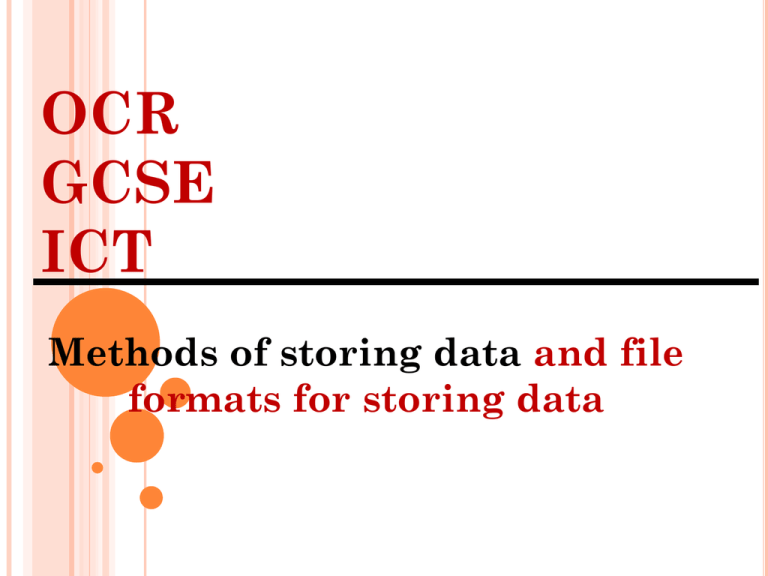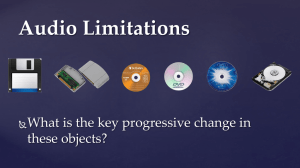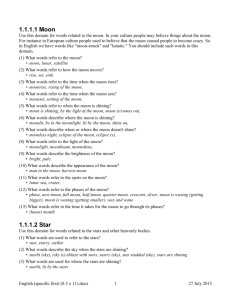OCR Cambridge Nationals
advertisement

OCR GCSE ICT Methods of storing data and file formats for storing data FILE MANAGEMENT -WHY IT IS IMPORTANT Why is File Management important? It helps for Jackie and Cable Ties Ltd to stay organised, so that information can be located by her or any other authorised person. Setting up a good structure with sensible file names saves time in the long term. A sensible file name is a name that best describes the information that is contained in the file. FILE MANAGEMENT -WHY IT IS IMPORTANT Naming Conventions Jackie has created a FILE called New_Clients_April 17th 2014_V1.docx This shows that the file is called New Clients and that it is Version 1 and the date shows the time when Jackie last updated the file without having have to open it. Now Jackie needs to create a FOLDER to store the file or document. FILE MANAGEMENT -WHY IT IS IMPORTANT FOLDERS A FOLDER is a container for storing files. A SUB-FOLDER is a folder within a folder. This may be CLIENTS, TECHNICIANS, EQUIPMENT etc FILES Jackie knows that the folders must be understandable to others. A file is the name given to every document that you save on your computer such as word processing, spreadsheet, databases or images. They all have different file extensions for example docx, jpeg. Jackie when she saves her work she saves it in her normal file type e.g. word processing will be .docx AND as a PDF so that the formatting and features will not be lost. Hierarchical Folder Structure Clients Clients 2014 Clients 2014 Cable Ties Ltd Technicians Equipment Clients 2013 Clients 2013 Chief Technicians Technicians Electrical Equipment Archiving • Archiving is a backup that is taken in case the original is lost. • Archives are the backups that are not needed in the immediate short term but maybe required for future reference • Instead of saving these files on computer it is better to save them on backing removable storage (as mentioned previously) and store them in a fireproof building away from the main site LESSON OVERVIEW In this lesson you will learn about various file formats used, the reason they are needed and the difference between open source and proprietary formats. INTRODUCTION You will have seen file formats every time you are in a ICT lesson. WHY ARE THEY NEEDED? Files created by software applications are stored so that they can be retrieved for later use. A particular file format will tell the operating system which application needs to open it. .docx = Word file .psd = Photoshop file .xlsx = Excel spreadsheet file .swf = Flash Player file .pubx = Desktop publisher file .wmv = Windows Media Player file .pptx = PowerPoint file .pdf = Acrobat file .mdbx = Access database file The unique set of letters are used to ensure that the files are opened quickly by the correct applications. STRUCTURE Each file format follows a certain structure. .pptx .docx .pub .avi .wmv .jpg . docx Full stop Unique group of letters TASK 1 Resource 1 – file type software icon Match the file type icons to the programs that open them. PROPRIETARY & OPEN FORMATS File formats can be grouped into two types: Proprietary Proprietary formats are those owned by commercial companies and are only used by software made by the owners. Open Open formats are used by a variety of software applications and can be used to transfer data between applications. TASK 2 Open up, Resource 2 - Spider Diagram (proprietary and open formats).docx TASK 2 – PROPRIETARY FORMATS As a class fill in the empty boxes Format Meaning Typically used to store .doc .docx Microsoft Word document Word-processed letters and other typed documents .xls .xlsx .ppt .pptx .fla .wma TASK 2 – PROPRIETARY FORMATS Format Meaning Typically used to store .doc .docx Microsoft Word document Word-processed letters and other typed documents .xls .xlsx Microsoft Excel document Spreadsheets .ppt .pptx Microsoft Powerpoint document Slideshow presentation .fla Adobe Flash movie/animation Animations/movies .wma Windows Media Audio Audio/sounds TASK 2 – OPEN FORMATS As a class fill in the empty boxes Format .aac .rtf .csv .exe .txt .pdf .mp3 .aiff .wav Meaning Advanced audio coding Typically used to store Audio/sound stored without loss of data TASK 2 – OPEN FORMATS As a class fill in the empty boxes Format .aac Meaning Advanced audio coding Typically used to store Audio/sound stored without loss of data .rtf Rich text format Word-processed documents .csv Comma separated values Lists of data used to transfer data between applications .exe Executable file Applications that can be run on computer systems .txt Text Unformatted text files .pdf Portable document format Formatted documents .mp3 MPEG audio layer 3 Audio/sound store with loss of data .aiff Apples audio format Audio/sound .wav Microsoft audio format Audio/sound EXAM STYLE QUESTIONS











